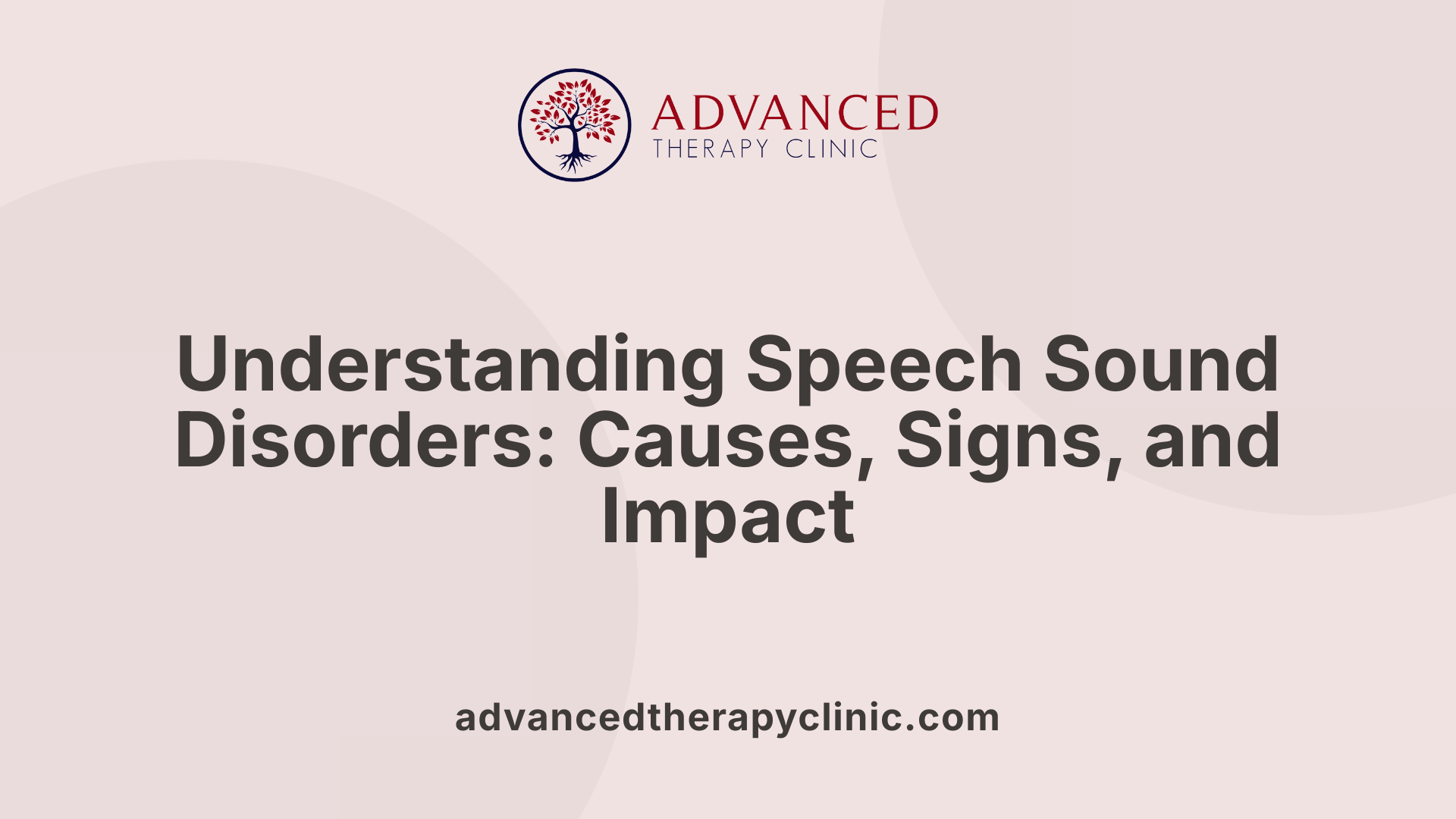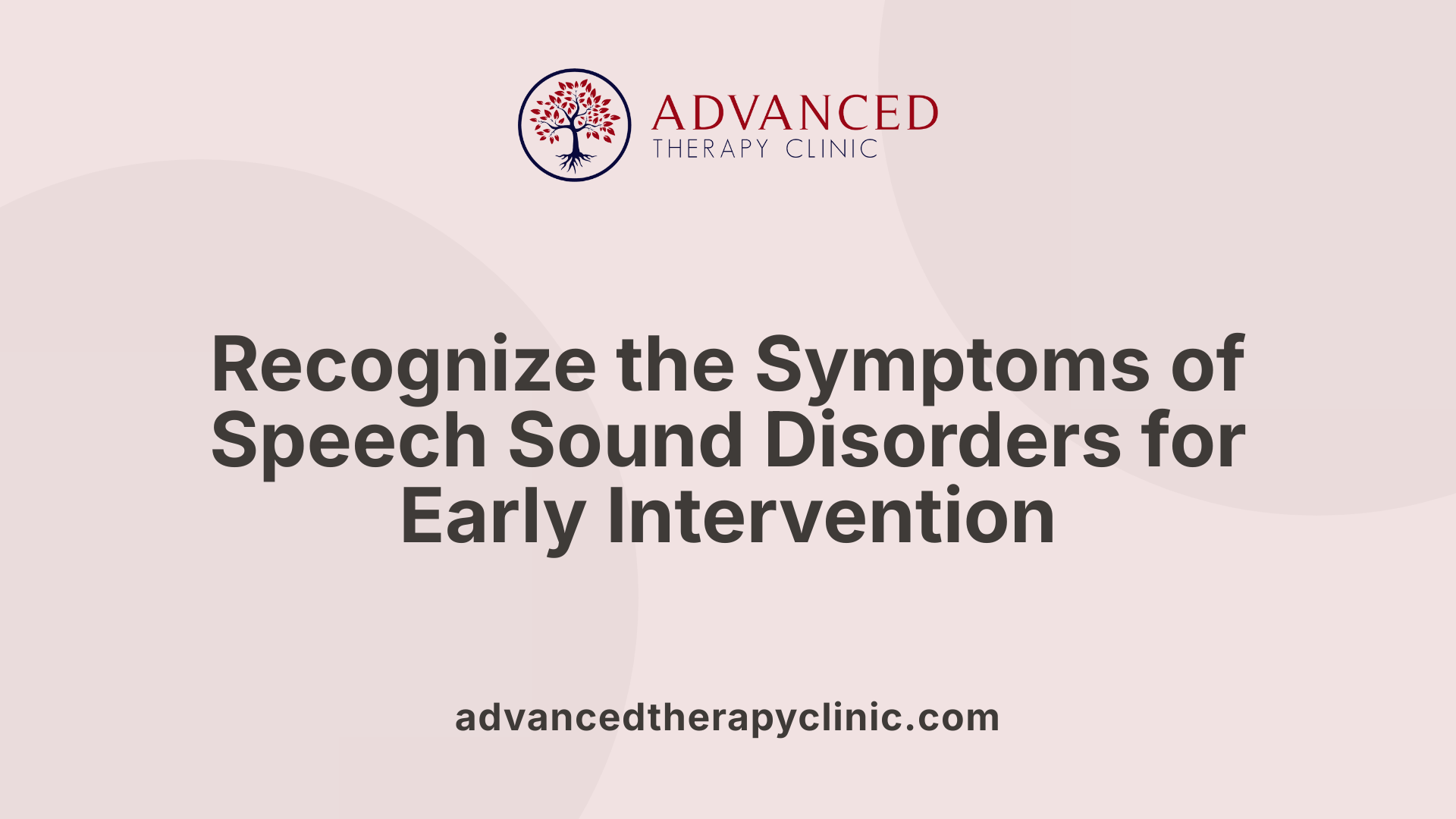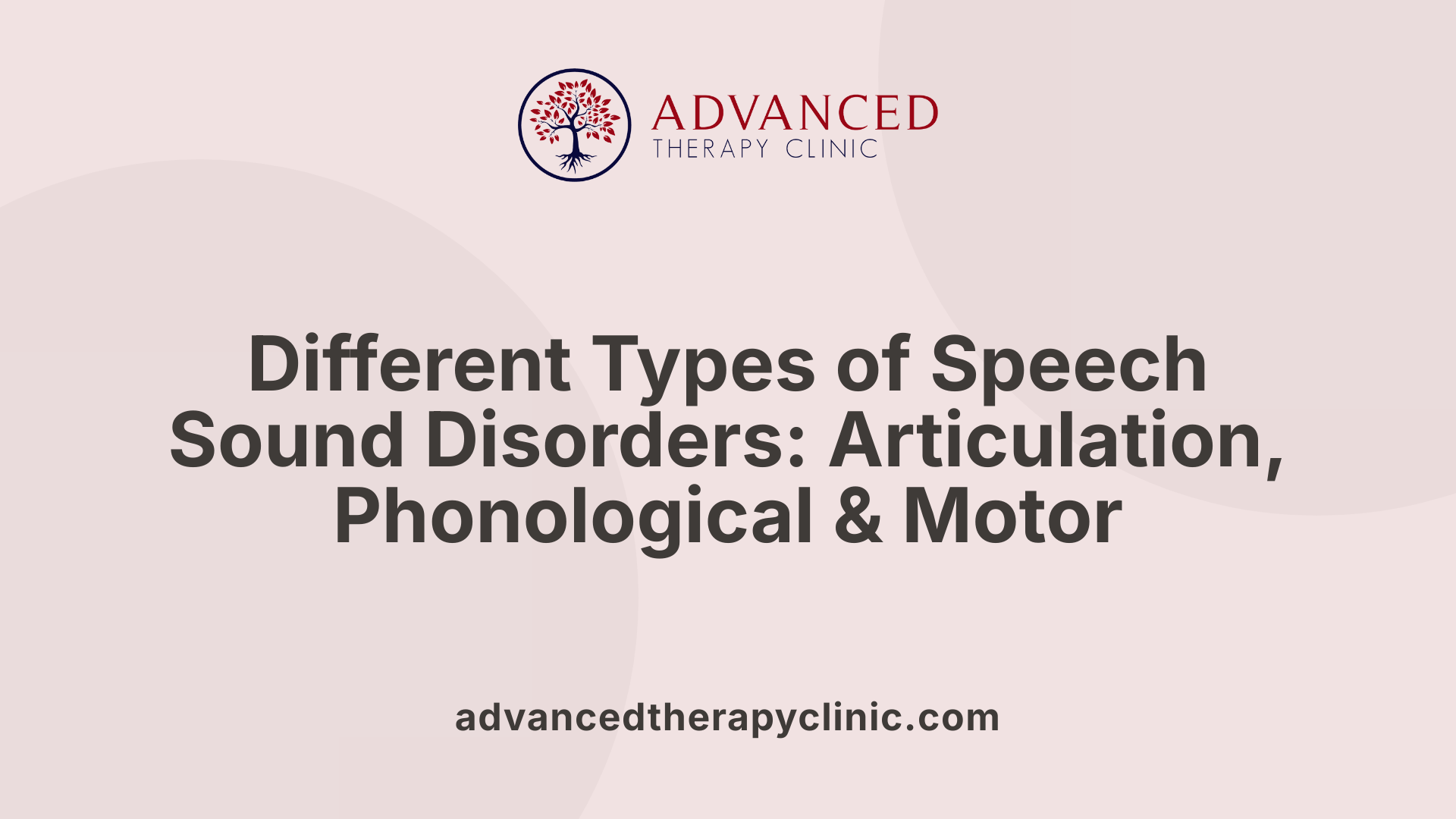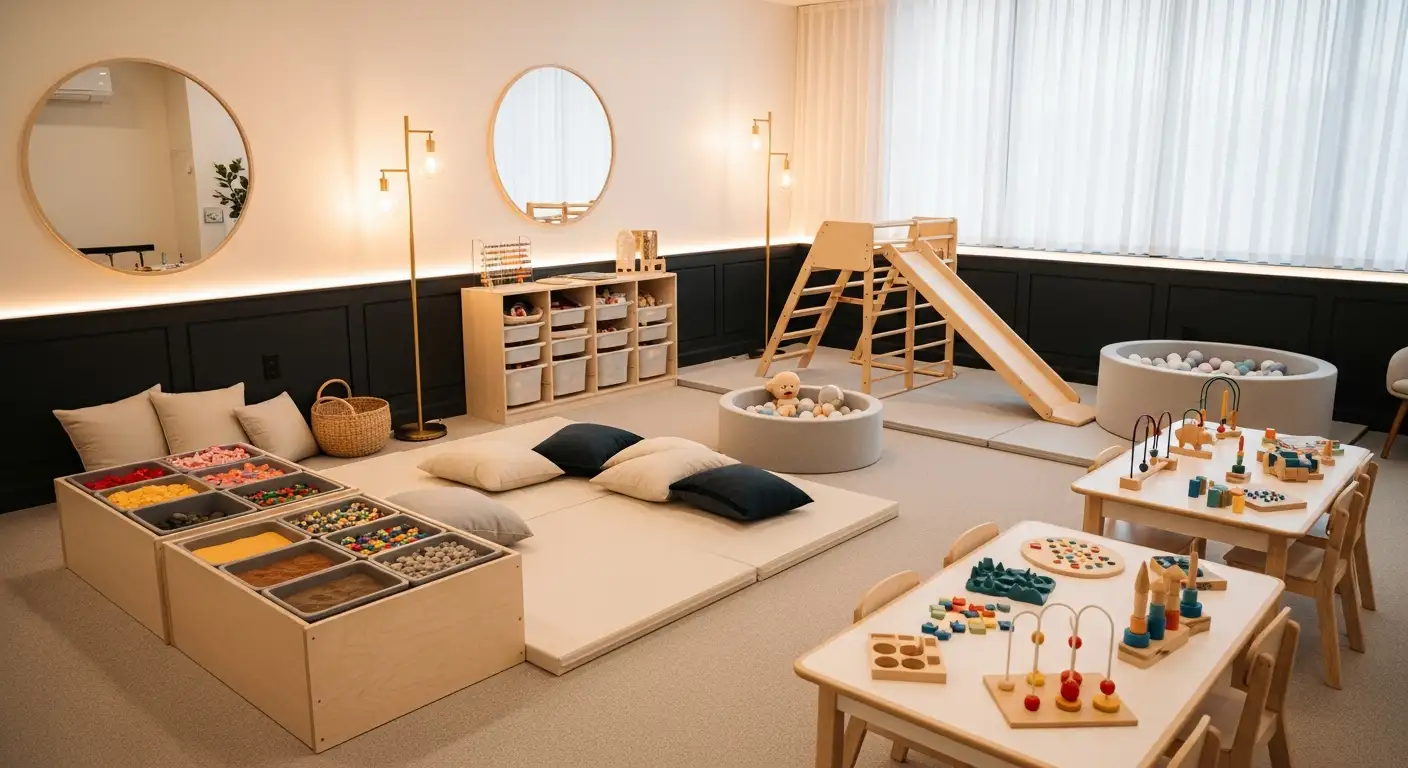What Is Speech Sound Disorder


Unpacking the Complexities of Speech Sound Disorders
Speech sound disorder (SSD) is a broad term encompassing various difficulties in perceiving, articulating, and organizing speech sounds. These challenges can significantly impact an individual's ability to communicate effectively, affecting social, academic, and emotional development. This article aims to provide a comprehensive understanding of SSDs, including their causes, symptoms, classifications, assessments, and treatment options, with a particular focus on childhood manifestations and implications.
Definition and Overview of Speech Sound Disorder

What is a speech sound disorder and how is it characterized?
A speech sound disorder (SSD) is a condition marked by difficulties in perceiving, motorically producing, or phonologically representing speech sounds, leading to challenges in speech clarity and overall communication. Children with SSD may struggle with articulation, where specific sounds are not correctly produced, or with phonological patterns, where the use of sounds follows atypical or delayed patterns that hinder understanding. This condition can either be organic, stemming from physical or neurological issues such as structural anomalies or brain injury, or idiopathic, meaning the cause remains unknown, which is common in preschool and school-age children between ages 3 and 21. Signs of SSD include a variety of speech errors such as omissions (leaving out sounds), substitutions (replacing one sound with another), distortions (imprecise sound production), additions, and inconsistent errors in whole words. While many children naturally outgrow speech errors, persistence beyond the typical developmental age suggests a disorder. Diagnosis involves comprehensive assessment by speech-language pathologists (SLPs), who analyze speech patterns, collect language samples, and perform formal tests to identify specific impairments. Treatment focuses on improving sound production through targeted therapy approaches such as phonological contrast therapy, cycles approach, or naturalistic methods, alongside early intervention to foster better communicative and social skills.
Impact of SSD on communication and development
Speech sound disorders can profoundly affect a child's social, academic, and emotional development. Children with unresolved SSD often face difficulties being understood, which may cause frustration, reduced confidence, and social withdrawal. These social challenges can lead to emotional issues like low self-esteem and anxiety. Behavioral and social consequences tend to worsen with age if the disorder remains untreated. For instance, children with persistent errors in sounds like /r/ may experience teasing or bullying, impacting their mental health and social participation. Academically, SSDs can interfere with literacy development. Difficulties in phonological awareness—understanding how sounds work in words—are linked to struggles with reading and spelling, especially when co-occurring language impairments are present. Long-term impacts include restrictions in employment opportunities and ongoing activity limitations into adulthood, as communication is fundamental for social and professional interactions. Addressing SSD early with appropriate speech therapy is vital. This not only improves speech clarity but also enhances social interaction, emotional well-being, and academic success, highlighting the importance of comprehensive, individualized intervention plans.
Causes and Factors Contributing to Speech Sound Disorder

What are the common causes and contributing factors of speech sound disorder?
Speech sound disorders (SSDs) can arise from an array of underlying causes, often involving interactions between physical, neurological, developmental, and environmental factors. Understanding these causes helps clinicians design effective assessment and treatment plans tailored to each child's needs.
Developmental delays are a common contributor to SSDs. Some children simply take longer to acquire speech sounds, but persistent delays beyond typical age ranges may indicate a disorder. Such delays can be due to general speech and language developmental issues or specific deficits in speech sound production.
Structural abnormalities of the speech apparatus play a significant role. Conditions like cleft lip and palate, tongue-tie, or large tonsils and adenoids can physically interfere with typical speech production. These anatomical issues may require surgical intervention alongside speech therapy to improve articulation.
Neurological conditions are another major cause of SSDs. Disorders like childhood apraxia of speech, cerebral palsy, or neurological injury from trauma or illness can impair the planning, coordination, and execution of speech movements. For example, apraxia involves difficulty planning the motor sequences necessary for speech, despite understanding what to say.
Sensory issues, particularly hearing loss, are known to impact speech development significantly. Children with chronic ear infections or sensorineural hearing loss might not develop accurate speech sounds because they cannot hear the differences in sounds clearly. This can lead to substitutions, omissions, or distortions of speech sounds.
Genetic and family history factors also influence SSD risk. Children with relatives who have speech or language challenges are more likely to develop similar issues, possibly due to inherited structural or neurological traits.
Environmental influences, including limited exposure to speech models or language-rich interactions, can also contribute to speech delays and disorders. During critical learning periods, children benefit from ample speech and language stimulation, and deficits here can hinder typical speech sound acquisition.
In many cases, the exact cause of a child's speech sound disorder remains unknown, classified as idiopathic. However, research indicates that factors such as pre- and perinatal complications, premature birth, low birthweight, and persistent otitis media with effusion (middle ear infections) increase the likelihood of SSDs.
Overall, causes of SSDs are often multifaceted, involving biological, neurological, genetic, and environmental components. Recognizing these diverse factors is essential for accurate diagnosis and effective intervention.
| Cause Type | Examples | Additional Details |
|---|---|---|
| Developmental | Language delays, speech motor planning issues | Often seen as part of broader developmental delays or learned behaviors |
| Structural | Cleft palate, tongue-tie | External physical features impacting sound production |
| Neurological | Apraxia, cerebral palsy | Affect planning, coordination, and execution of speech movements |
| Sensory | Hearing loss, ear infections | Hindrances to perceiving speech sounds accurately |
| Genetic & Family Factors | Family history of speech/language issues | Inherited predisposition to speech difficulties |
| Environmental | Limited speech exposure, lack of interaction | Insufficient language stimulation during critical growth periods |
Understanding these causes offers crucial insight for clinicians, educators, and families to support children with SSDs effectively.
Symptoms and Signs of Speech Sound Disorder

What are the typical symptoms and signs that indicate a speech sound disorder?
Children with speech sound disorders often show several recognizable patterns in their speech that deviate from typical development. One prominent sign is inconsistency in speech errors, meaning that the same word might be pronounced differently at different times. This inconsistency is particularly characteristic of complex speech issues like Childhood Apraxia of Speech.
Another common indicator is difficulty in pronouncing specific sounds or words beyond the age when most children have mastered them. For example, a child might omit sounds (like saying 'oo' instead of 'school'), substitute one sound for another (saying 'wadio' for 'radio'), or distort sounds in ways that make the speech hard to understand.
Children with SSD may also add extra sounds within words or produce them with distorted qualities, such as lisping or slurring. Additionally, they might use simplified speech patterns, including leaving out consonants or syllables, which impacts clarity.
Speech errors can manifest at the syllable level, such as difficulty with syllable repetition or producing only one syllable where more are expected. These errors are often persistent, unlike typical preschool speech development where most sounds are acquired by age 3.
Signs beyond speech errors include reduced speech intelligibility, which can hinder effective communication in social, educational, and occupational settings. Sometimes, SSD is accompanied by perceptual or motor difficulties, such as trouble with speech muscle movement or phonological processes that are atypical.
The importance of early detection cannot be overstated. If a child's speech patterns show these signs past the typical age milestones, an evaluation by a speech-language pathologist is necessary. This professional can assess whether the child's speech errors are developmental or indicative of a disorder, and plan suitable intervention strategies.
In summary, typical signs and symptoms of SSD include inconsistent speech errors, omission, substitution, addition, or distortion of sounds, syllable simplification, and ongoing speech difficulty beyond childhood norms. Recognizing these signs allows for timely diagnosis and effective treatment, helping children improve their speech clarity and overall communication skills.
Classification and Types of Speech Sound Disorder

How is speech sound disorder classified and what are its different types?
Speech sound disorder (SSD) is a broad term encompassing various difficulties children experience in producing speech sounds correctly. It is generally classified into three main categories: articulation disorders, phonological disorders, and motor speech disorders.
Articulation disorders involve difficulties with the physical production of specific sounds. Children with articulation disorders may substitute, distort, omit, or add sounds in words. For example, a child might say "wadio" instead of "radio" or "fwing" instead of "swing." Most children correctly produce nearly all sounds by age five, but those with articulation disorders struggle beyond expected developmental milestones.
Phonological disorders concern patterns of speech errors related to the organization and use of sounds in the language. These children often exhibit consistent or inconsistent patterns such as deleting sounds (omissions), substituting sounds, or simplifying complex words, which can make their speech difficult to understand. These disorder types often involve error patterns like final consonant deletion or cluster reduction and may persist past typical ages. They reflect underlying issues with the child's phonological system rather than motor difficulty.
Motor speech disorders involve difficulties with planning, coordination, or execution of speech movements. Examples include childhood apraxia of speech, where the brain has trouble planning the precise movements needed for speech, and dysarthria, caused by weakness or paralysis of speech muscles. These conditions often require specialized assessment and intervention because the root cause is motor control rather than sound pattern organization.
Further classification can also consider causes, such as idiopathic origins where no specific cause is identified, or developmental issues linked to neurological or structural factors. Severity varies, with some children experiencing mild difficulties that resolve with therapy, while others have persistent speech challenges.
Understanding these categories helps speech-language pathologists develop targeted treatment strategies suited to each child's specific difficulty, ensuring more effective intervention.
Additional insights into SSD classification
| Classification Type | Main Feature | Typical Errors or Characteristics | Implications for Treatment |
|---|---|---|---|
| Articulation Disorders | Physical production difficulty | Substitutions, distortions, omissions, additions | Focused on motor skills, sound production practice |
| Phonological Disorders | Patterns of error in sound system | Consistent or inconsistent error patterns related to language rules | Phonological awareness, pattern correction strategies |
| Motor Speech Disorders | Motor planning and execution issues | Apraxia: inconsistent speech, difficulty planning movements | Intensive motor planning exercises, speech drills |
This classification aids in selecting the appropriate therapeutic approach, whether it emphasizes motor skills, phonological awareness, or a combination of both. Recognizing the different types of SSDs also informs ongoing assessment, prognosis, and intervention planning, ultimately improving communication outcomes for affected children.
Assessment and Diagnosis Methods

What methods are used to diagnose and assess speech sound disorder?
Diagnosing and assessing speech sound disorders (SSDs) involves a variety of methods to thoroughly understand the nature and severity of a child's difficulties. Speech-language pathologists (SLPs) utilize a combination of screening procedures, formal testing, and observational assessments tailored to each child's age, linguistic background, and specific needs.
Initially, screening procedures help determine whether a child's speech development falls within typical ranges or signals the need for further evaluation. These quick checks are designed to identify children who may have underlying speech issues that warrant detailed assessment.
A comprehensive assessment typically includes collecting speech samples through play-based activities, conversational speech, and structured elicitation tasks. Speech samples are analyzed for error patterns such as omissions, substitutions, distortions, and additions. Formal standardized tests are used to measure phoneme production accuracy, phonological processes, and overall intelligibility, providing norm-referenced scores that compare the child's speech to typical developmental milestones.
In addition to speech assessments, optional but important components include:
- Hearing Screening: Ensures that hearing loss is not contributing to speech difficulties.
- Oral Motor Examination: Assesses the structure and function of speech-related muscles and organs like the lips, tongue, palate, and jaw.
- Stimulability Testing: Determines if the child can produce correct sounds with external cues, guiding therapy goals.
- Speech Perception Tasks: Evaluate the child's ability to discriminate between sounds, which may influence phonological processing.
Assessment must also consider the child's linguistic environment, including dialectal and accent influences, especially in bilingual or multilingual contexts. Understanding these factors helps prevent misdiagnosis and ensures culturally appropriate evaluation.
Moreover, the child's developmental history, presence of co-occurring language or cognitive impairments, and social factors are integrated into the assessment process. This holistic approach supports accurate diagnosis, helping distinguish between articulation disorders, phonological processes, and other related speech or language impairments.
The overall goal of these methods is to precisely identify the specific speech impairments, classify the disorder appropriately, and inform effective intervention strategies. Monitoring progress over time using standardized measures and clinical observations ensures that therapy remains effective and responsive to the child's evolving needs.
This multi-faceted assessment approach aligns with international guidelines, emphasizing evidence-based practices and the importance of personalized evaluation to optimize treatment outcomes for children with SSDs.
| Assessment Component | Description | Additional Notes |
|---|---|---|
| Screening procedures | Quick initial checks to identify potential speech issues | Serves as a gateway to detailed assessment |
| Speech sampling | Collecting spontaneous and structured speech samples | Analyzes errors and intelligibility |
| Formal standardized tests | Norm-referenced tools assessing phonemic accuracy | Guide diagnosis and progress measurement |
| Hearing screening | Tests for hearing acuity, ruling out auditory causes | Critical to exclude hearing loss as factor |
| Oral motor assessment | Examines muscles and articulators involved in speech | Identifies structural or functional issues |
| Stimulability testing | Checks if correct production is possible with cues | Guides targeted intervention strategies |
| Speech perception tasks | Assesses ability to discriminate speech sounds | Important for phonological understanding |
Understanding these assessment methods helps clinicians deliver precise diagnoses, leading to effective, individualized treatment plans that improve speech clarity and communication skills in children.
Treatment Options and Strategies
What treatment options and intervention strategies are available for managing speech sound disorder?
Managing speech sound disorders involves a range of therapy approaches that are rooted in evidence-based practices. Speech-language pathologists (SLPs) tailor these strategies to meet each child's unique needs, developmental level, and specific speech issues.
One common approach is traditional articulation therapy. It focuses on teaching children how to produce specific speech sounds correctly through a series of modeling, practice, and feedback activities. For children with more complex phonological patterns, phonological process-focused interventions are used to target particular error patterns like final consonant deletion or cluster reduction.
The cycles approach is another effective method, especially for children with multiple phonological patterns. It involves rotating through different target sounds or processes over a set period, ensuring systematic practice and reinforcement.
Specific contrast therapies, such as minimal opposition, maximal opposition, and multiple oppositions, help children understand the differences between their incorrect and correct sounds. These techniques enhance their ability to distinguish and produce the correct sounds, facilitating more accurate speech.
To support speech acquisition, clinicians often set clear targets based on developmental norms, emphasizing establishing, generalizing, and maintaining correct sound production across various contexts. Activities are customized and made engaging to boost motivation and participation.
Generalization is a crucial goal of therapy—children need to transfer correct speech sounds from the clinic to everyday settings, including home and school. Strategies for this include situational practice, parent training, and home programs.
Maintenance involves ongoing reinforcement and practice to ensure the gains are sustained over time. Regular follow-up sessions and home practice contribute to long-term success.
Special considerations are necessary for multilingual and mult dialectal populations. Therapy approaches are adapted to account for the child's linguistic background, avoiding misdiagnosis or cultural bias. Incorporating knowledge of accents, dialects, and language-specific phonological rules ensures effective and respectful intervention.
While nonspeech oral exercises like strengthening or motor drills are popular among some practitioners, current research does not substantiate their effectiveness as primary treatment strategies. The focus remains on speech-centered activities that directly target speech sound production.
In summary, effective intervention combines multiple strategies tailored to the child, starting early and incorporating family involvement. Early, personalized, and culturally sensitive approaches maximize the chances of successful speech improvement and integration into everyday communication.
Bridging the Gap in Communication
Speech sound disorder (SSD) encompasses a complex range of speech production difficulties that can significantly affect a person's communication abilities and overall development. Early identification through comprehensive assessment, understanding of underlying causes, and targeted, evidence-based interventions are essential to mitigate the impact of SSD. With timely and tailored speech-language therapy, most individuals—especially children—can make substantial progress in improving their speech clarity, social participation, and academic success. Continued research and culturally sensitive practices will further enhance diagnosis and treatment, ultimately bridging the gap in effective communication for those affected by SSD.
References
- Speech Sound Disorders: Articulation and Phonology
- Speech Sound Disorders in Children
- Speech sound disorder
- Speech Sound Disorders
- Speech Sound Disorders and Pediatric Motor ...
- Speech Sound Disorders in Children: An Articulatory ...
- Speech Sound Disorders
- Speech Sound Disorders
- Clinical information on speech sound disorders
Recent articles

Expressive Speech Delay 2-Year-Old
Understanding and Addressing Expressive Speech Delay in Toddlers

How Speech Recognition Works
Unlocking the Power of Speech Recognition in Therapy and Healthcare

Autism and Head Size
Understanding the Complex Relationship Between Autism and Head Size

Occupational Therapy in Autism
Enhancing Independence and Quality of Life Through Occupational Therapy in Autism

Do Autistic People Understand Sarcasm?
Navigating the Nuances: Understanding Sarcasm and Social Communication in Autism

Autism Routines
Crafting Effective Daily Structures for Children with Autism

